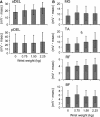Rhythmic arm swing enhances patterned locomotor-like muscle activity in passively moved lower extremities
- PMID: 25742956
- PMCID: PMC4393153
- DOI: 10.14814/phy2.12317
Rhythmic arm swing enhances patterned locomotor-like muscle activity in passively moved lower extremities
Abstract
The use of driven gait orthosis (DGO) has drawn attention in gait rehabilitation for patients after central nervous system (CNS) lesions. By imposing a passive locomotor-like kinematic pattern, the neural mechanisms responsible for locomotion can be activated as in a normal gait. To further enhance this activity, discussions on possible intervention are necessary. Given the possible functional linkages between the upper and lower limbs, we investigated in healthy subjects the degree of modification in the lower limb muscles during DGO-induced passive gait by the addition of swing movement in the upper extremity. The results clearly showed that muscle activity in the ankle dorsiflexor TA muscle was significantly enhanced when the passive locomotor-like movement was accompanied by arm swing movement. The modifications in the TA activity were not a general increase through the stride cycles, but were observed under particular phases as in normal gaits. Voluntary effort to swing the arms may have certain effects on the modification of the muscle activity. The results provide clinical implications regarding the usefulness of voluntary arm swing movement as a possible intervention in passive gait training using DGO, since ordinary gait training using DGO does not induce spontaneous arm swing movement despite its known influence on the lower limb movement.
Keywords: Arm swing; Lokomat; locomotor‐like EMG; passive stepping.
© 2015 The Authors. Physiological Reports published by Wiley Periodicals, Inc. on behalf of the American Physiological Society and The Physiological Society.
Figures






Similar articles
-
Intermuscular coherence analysis in older adults reveals that gait-related arm swing drives lower limb muscles via subcortical and cortical pathways.J Physiol. 2021 Apr;599(8):2283-2298. doi: 10.1113/JP281094. Epub 2021 Mar 19. J Physiol. 2021. PMID: 33687081 Free PMC article.
-
Shaping appropriate locomotive motor output through interlimb neural pathway within spinal cord in humans.J Neurophysiol. 2008 Jun;99(6):2946-55. doi: 10.1152/jn.00020.2008. Epub 2008 Apr 30. J Neurophysiol. 2008. PMID: 18450579 Clinical Trial.
-
Contributions to the understanding of gait control.Dan Med J. 2014 Apr;61(4):B4823. Dan Med J. 2014. PMID: 24814597 Review.
-
Arm sway holds sway: locomotor-like modulation of leg reflexes when arms swing in alternation.Neuroscience. 2014 Jan 31;258:34-46. doi: 10.1016/j.neuroscience.2013.10.007. Epub 2013 Oct 18. Neuroscience. 2014. PMID: 24144625
-
The how and why of arm swing during human walking.Gait Posture. 2013 Sep;38(4):555-62. doi: 10.1016/j.gaitpost.2013.02.006. Epub 2013 Mar 13. Gait Posture. 2013. PMID: 23489950 Review.
Cited by
-
Intermuscular coherence analysis in older adults reveals that gait-related arm swing drives lower limb muscles via subcortical and cortical pathways.J Physiol. 2021 Apr;599(8):2283-2298. doi: 10.1113/JP281094. Epub 2021 Mar 19. J Physiol. 2021. PMID: 33687081 Free PMC article.
-
Changes in Gait Performance in Stroke Patients after Taping with Scapular Setting Exercise.Healthcare (Basel). 2020 May 8;8(2):128. doi: 10.3390/healthcare8020128. Healthcare (Basel). 2020. PMID: 32397219 Free PMC article.
-
Using a simple rope-pulley system that mechanically couples the arms, legs, and treadmill reduces the metabolic cost of walking.J Neuroeng Rehabil. 2021 Jun 7;18(1):96. doi: 10.1186/s12984-021-00887-3. J Neuroeng Rehabil. 2021. PMID: 34098979 Free PMC article.
-
The Effects of Proprioceptive Neuromuscular Facilitation Pattern Kinesio Taping on Arm Swing, Balance, and Gait Parameters among Chronic Stroke Patients: A Randomized Controlled Trial.Life (Basel). 2024 Feb 8;14(2):242. doi: 10.3390/life14020242. Life (Basel). 2024. PMID: 38398751 Free PMC article.
-
A Review of Classification Techniques of EMG Signals during Isotonic and Isometric Contractions.Sensors (Basel). 2016 Aug 17;16(8):1304. doi: 10.3390/s16081304. Sensors (Basel). 2016. PMID: 27548165 Free PMC article. Review.
References
-
- Andersson O. Grillner S. Peripheral control of the cat's step cycle. II. Entrainment of the central pattern generators for locomotion by sinusoidal hip movements during “fictive locomotion”. Acta Physiol. Scand. 1983;118:229–239. - PubMed
-
- Arányi Z. Rösler KM. Effort-induced mirror movements. A study of transcallosal inhibition in humans. Exp. Brain Res. 2002;145:76–82. - PubMed
-
- Baldissera F, Cavallari P. Civaschi P. Preferential coupling between voluntary movements of ipsilateral limbs. Neurosci. Lett. 1982;34:95–100. - PubMed
-
- Baldissera F, Cavallari P, Marini G. Tassone G. Differential control of in-phase and anti-phase coupling of rhythmic movements of ipsilateral hand and foot. Exp. Brain Res. 1991;83:375–380. - PubMed
-
- Calancie B, Needham-Shropshire B, Jacobs P, Willer K, Zych G. Green BA. Involuntary stepping after chronic spinal cord injury. Evidence for a central rhythm generator for locomotion in man. Brain. 1994;117:1143–1159. - PubMed
LinkOut - more resources
Full Text Sources
Other Literature Sources

